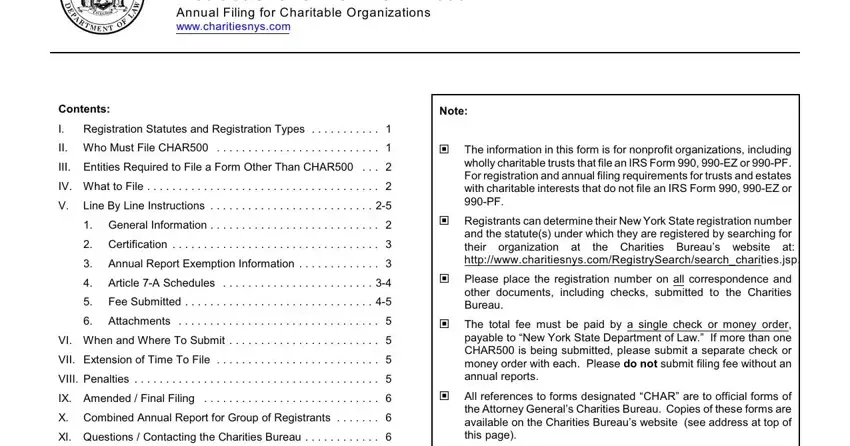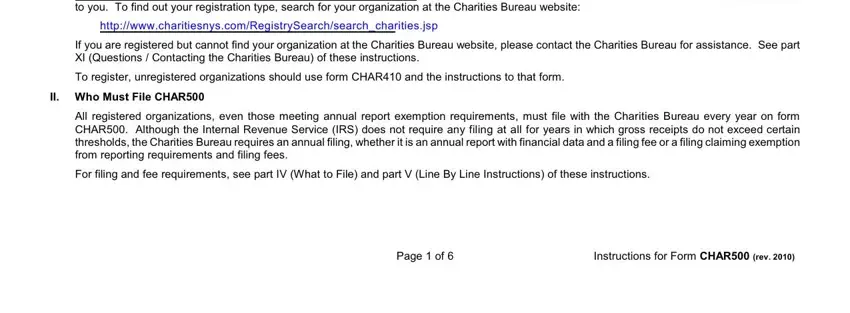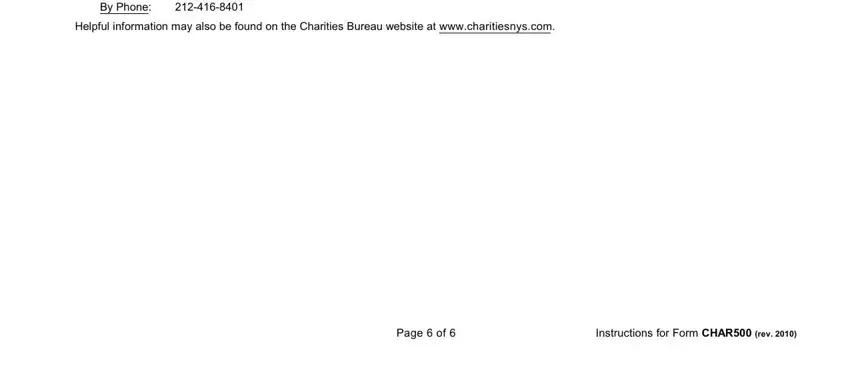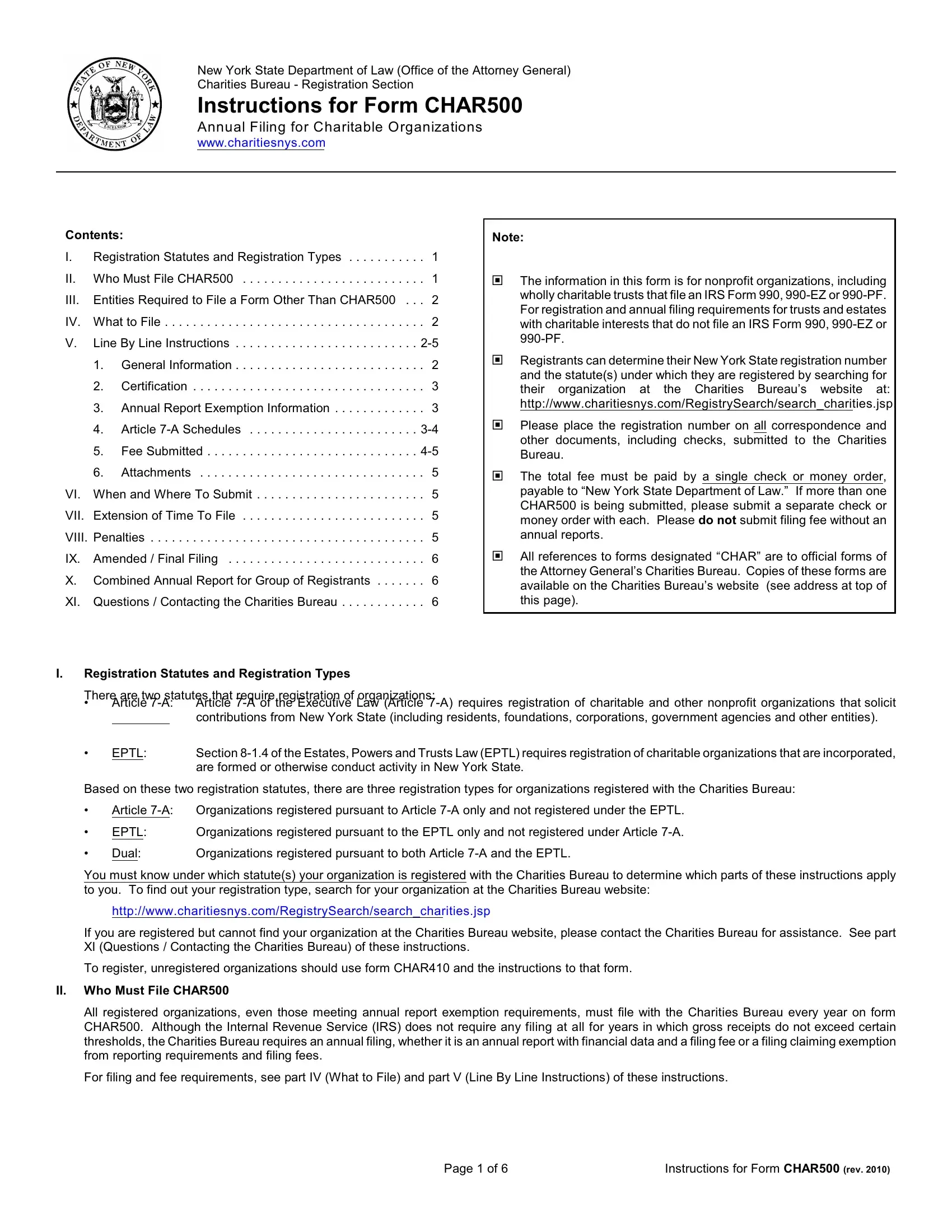III.Entities Required to File a Form Other Than CHAR500
The following registered charitable entities should not use CHAR500 for annual filings with the Charities Bureau::
•trusts that are not wholly charitable but that have charitable interests (note: wholly charitable trusts that file an IRS Form 990, 990-EZ or 990-PF must use CHAR500); and
•estates with charitable interests.
All other registrants must file form CHAR500 each year.
IV. What to File
Follow the instructions in part V (Line by Line Instructions) to determine which sections of the CHAR500 your organization must complete and which schedules, attachments and fees your organization must attach to your organization’s CHAR500.
Please clip or staple together as one package the CHAR500 with any required schedules and attachments. Please do not staple schedules or attachments separately. When submitting an accountant’s report, please do not submit a bound copy.
All fees must be paid by a single check or money order, payable to “New York State Department of Law.” Please write your organization’s registration number on your payment. Clip (do not staple)your payment to the front of the CHAR500. Do not submit payment separately from the CHAR500.
V.Line By Line Instructions
You must know your organization’s registration type to determine which parts of these instructions apply to your organization. For more information, see part I (Registration Statutes and Registration Types) of these instructions.
1.General Information
a.Fiscal year beginning and ending:
Enter the month, day and year for both the beginning and end of the report’s accounting period, whether your organization has a calendar year accounting period (e.g., January 1, 2004 to December 31, 2004) or a different full year accounting period (e.g., July 1, 2004 to June 30, 2005) or is filing for a period shorter than a year (e.g., July 1, 2004 to December 31, 2004).
b.Checkboxes:
Address change: Check this box if the organization changed its address since it submitted its previous filing.
Name change: Check this box if the organization has changed its name since it submitted its previous filing and attach a completed form CHAR410-A with all required attachments.
Initial filing:If the organization recently registered with the Charities Bureau and is submitting its first annual filing, check this box. If the organization has not yet registered, it must register using form CHAR410.
Final filing:Organizations should file final filings when they cease operations and/or dissolve. You must check this box and attach to the CHAR500 a copy of the IRS 990, 990-EZ or 990-PF marked “Final return” with all required attachments filed with the IRS.
If the organization is incorporated in New York State, you must attach either a certificate of dissolution from the New York State Department of State or a document describing the organization’s plans to obtain a certificate of dissolution from the Department of State.
If the organization is incorporated in another state, you must attach a certificate of dissolution from the appropriate agency in that state.
The final filing checkbox may not be used to claim exemption from Charities Bureau registration and filing requirements. To claim such an exemption, use form Schedule E (Request for Registration Exemption for Charitable Organizations) and the instructions to that form.
Amended filing: If submitting an amended filing, you must check this box and attach to the CHAR500 a copy of the IRS 990, 990-EZ or 990-PF marked “Amended return” with all required attachments filed with the IRS.
If the Charities Bureau filing fee required under the amended report is higher than the fee submitted as part of the original filing, submit a payment covering the difference. If information in the required attachments has changed (e.g., accountant’s audit report), submit the revised documents as attachments to the amended filing.
NY reg. pending: If the organization's New York State registration is pending, check this box and complete the filing.
c.Organization Information:
•State the name of the organization as it is registered with the Charities Bureau.
•State the mailing address of the organization.
d.Federal Employer Identification Number (EIN): State the organization’s EIN on record with the IRS.
e.NY State Registration No.:
If you do not know your New York State Registration Number, search for your organization at the Charities Bureau website: http://www.charitiesnys.com/RegistrySearch/search_charities.jsp
If you are registered but cannot find your organization at the Charities Bureau website, please contact the Charities Bureau for assistance. See part XI (Questions / Contacting the Charities Bureau) of these instructions.
f.Telephone Number: State the telephone number of the organization where a key person responsible for the organization’s annual filing can be reached.
g.Email: State the email address of the organization where a key person responsible for the organization’s annual filing can be reached.









